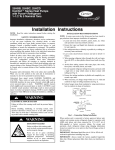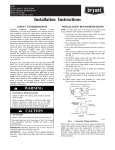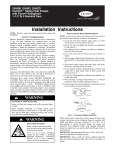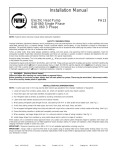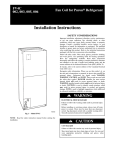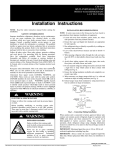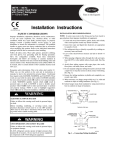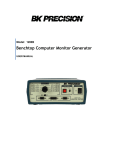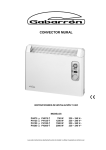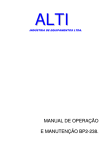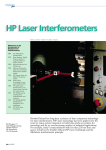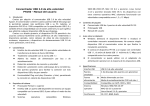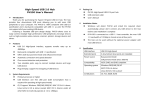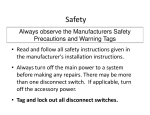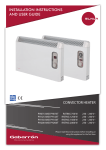Download Installation Instructions
Transcript
PH13N(P)B – SIZES 018 – 061 SPLIT–SYSTEM HEAT PUMP WITH R–410A REFRIGERANT Installation Instructions SAFETY CONSIDERATIONS Improper installation, adjustment, alteration, service, maintenance, or use can cause explosion, fire, electrical shock, or other conditions which may cause death, personal injury, or property damage. Consult a qualified installer, service agency, or your distributor or branch for information or assistance. The qualified installer or agency must use factory–authorized kits or accessories when modifying this product. Refer to the individual instructions packaged with the kits or accessories when installing. Follow all safety codes. Wear safety glasses, protective clothing, and work gloves. Use quenching cloth for brazing operations. Have fire extinguisher available. Read these instructions thoroughly and follow all warnings or cautions included in literature and attached to the unit. Consult local building codes and National Electrical Code (NEC) for special requirements. Recognize safety information. This is the safety–alert symbol ! When you see this symbol on the unit and in instructions or manuals, be alert to the potential for personal injury. Understand these signal words: DANGER, WARNING, and CAUTION. These words are used with the safety–alert symbol. DANGER identifies the most serious hazards which will result in severe personal injury or death. WARNING signifies hazards which could result in personal injury or death. CAUTION is used to identify unsafe practices which may result in minor personal injury or product and property damage. NOTE is used to highlight suggestions which will result in enhanced installation, reliability, or operation. WARNING ! ELECTRICAL SHOCK HAZARD Failure to follow this warning could result in personal injury or death. Before installing, modifying, or servicing system, main electrical disconnect switch must be in the OFF position. There may be more than 1 disconnect switch. Lock out and tag switch with a suitable warning label. INSTALLATION RECOMMENDATIONS NOTE: In some cases noise in the living area has been traced to gas pulsations from improper installation of equipment. 1. Locate unit away from windows, patios, decks, and so forth, where unit operation sound may disturb customer. 2. Insure that vapor– and liquid–tube diameters are appropriate to capacity of unit. 3. Run refrigerant tubes as directly as possible by avoiding unnecessary turns and bends. 4. Leave some slack between structure and unit to absorb vibration. 5. When passing refrigerant tubes through the wall, seal opening with RTV or other pliable silicon–based caulk. (See Fig. 1.) 6. Avoid direct tubing contact with water pipes, duct work, floor joists, wall studs, floors, and walls. 7. Do not suspend refrigerant tubing from joists and studs with a rigid wire or strap that comes in direct contact with tubing. (See Fig. 1.) 8. Ensure that tubing insulation is pliable and completely surrounds vapor tube. 9. When necessary, use hanger straps which are 1 in. wide and conform to shape of tubing insulation. (See Fig. 1.) 10. Isolate hanger straps from insulation by using metal sleeves bent to conform to shape of insulation. ! CAUTION UNIT OPERATION HAZARD Failure to follow this caution may result in improper product operation. Do not bury more than 36” (914 mm) of line set underground. Refrigerant may migrate to cooler buried section during extended periods of unit shut–down, causing refrigerant slugging and possible compressor damage at start–up.If ANY section of the line set is buried underground, provide a minimum 6” (152 mm) vertical rise at the service valve. OUTDOOR WALL ! WARNING UNIT OPERATION AND SAFETY HAZARD LIQUID TUBE INSULATION Failure to follow this warning could result in personal injury or equipment damage. R–410A refrigerant systems operate at higher pressures than standard R–22 systems. Do not use R–22 service equipment or components on R–410A refrigerant equipment. INDOOR WALL CAULK SUCTION TUBE THROUGH THE WALL JOIST HANGER STRAP (AROUND SUCTION TUBE ONLY) INSULATION SUCTION TUBE 1” MIN LIQUID TUBE SUSPENSION A07588 Fig. 1 – Connecting Tubing Installation GENERAL INSPECT NEW UNIT File claim with shipping company prior to installation if shipment is damaged or incomplete. Locate unit rating plate on unit service panel. It contains information needed to properly install unit. Check rating plate to be sure unit matches job specifications. LOCATION Check local codes for regulations concerning zoning, noise, platforms, and other issues. Locate unit away from fresh air intakes, vents, or bedroom windows. Noise may carry into the openings and disturb people inside. Locate unit in a well drained area, or support unit high enough so that water runoff will not enter the unit. Locate unit away from areas where heat, lint, or exhaust fumes will be discharged onto unit (as from dryer vents). Locate unit away from recessed or confined areas where recirculation of discharge air may occur (refer to CLEARANCES section of this document). Roof–top installation is acceptable providing the roof will support the unit and provisions are made for water drainage and noise/vibration dampening. NOTE: Roof mounted units exposed to wind may require wind baffles. Consult the manufacturer for additional information. INSTALL ON SOLID, LEVEL MOUNTING PAD If conditions or local codes require the unit be attached to pad, tie–down bolts should be used and fastened through knockouts provided in unit base pan. Refer to unit mounting pattern in Fig. 2 to determine base pan size and knockout hole location. Arrange supporting members to adequately support unit and minimize transmission of vibration to building. Consult local codes governing rooftop applications. B CLEARANCE REQUIREMENTS When installing, allow sufficient space for airflow clearance, wiring, refrigerant piping, and service. Allow 24 in. (609.6 mm) clearance to service end of unit and 48 in. (1219.2 mm) (above unit. For proper airflow, a 6–in. (152.4 mm) clearance on 1 side of unit and 12–in. (304.8 mm) on all remaining sides must be maintained. Maintain a distance of 24 in. (609.6 mm) between units or 18 in. (457.2 mm) if no overhang within 12 ft. (3.66 m) Position so water, snow, or ice from roof or eaves cannot fall directly on unit. On rooftop applications, locate unit at least 6 in. (152.4 mm) above roof surface. OPERATING AMBIENT The minimum outdoor operating ambient in cooling mode is 55_F (12.78_C), and the maximum outdoor operating ambient in cooling mode is 125_F (51.67_C). The maximum operating ambient in heating mode is 66_F (18.89_C). FILTER DRIER A field installed liquid–line filter drier is recommended for this installation. Refer to Fig. 3 and install filter drier as follows: 1. Braze 5 in. (127 mm) liquid tube to the indoor coil. 2. Wrap filter drier with damp cloth. 3. Braze filter drier to above 5 in. (127 mm) liquid tube. Flow arrow must point toward indoor coil. 4. Connect and braze liquid refrigerant tube to the filter drier. A A05227 Fig. 3 – Liquid Line Filter Drier Installed at Indoor Unit C CHECK DEFROST THERMOSTAT Check defrost thermostat to ensure it is properly located and securely attached. There is a liquid header with a brass distributor and feeder tube going into outdoor coil. At the end of one of the feeder tubes, there is a 3/8–in. O.D. stub tube approximately 2 in. (50.8 mm) long. (See Fig. 4.) The defrost thermostat should be located on stub tube. Note that there is only one stub tube used with liquid header, and on most units it is the bottom circuit. 3/8” D (9.53) Tiedown Knockouts (2) Places Base Pan Width x Depth in. (mm) 23–1/2 X 23–1/2 (596.9 X 596.9) 31–1/2 X 31–1/2 (800.1 X 800.1) Tie Down Knockouts in. (mm) A B C 4–7/19 (111.0) 6–9/16 (166.7) 18–1/16 (458.8) 24–11/16 (627.1) 7–3/16 (182.6) 9–1/8 (231.8) Fig. 2 – Tie Down Knockouts FEEDER TUBE STUB TUBE Minimum Mounting Pad Dimensions in. (mm) 26 x 26 (660 x 660) 35 X 35 (889 x 889) DEFROST THERMOSTAT A08073 Fig. 4 – Defrost Thermostat Location 2 A97517 INSTALL ADAPTER TUBE 1. Remove plastic retainer holding outdoor piston in liquid service valve. 2. Check outdoor piston size with matching number listed on unit rating plate. 3. Locate plastic bag taped to unit containing adapter tube. 4. Remove Teflon washer from bag and install in open end of liquid service valve. See Fig. 5. 5. Remover adapter tube from bag and connect threaded nut to liquid service valve. Tighten nut finger–tight and then with wrench an additional 1/2 turn (15 ft. lb). DO NOT OVER TIGHTEN! OUTDOOR UNIT CONNECTED TO FACTORY APPROVED INDOOR UNIT Outdoor unit contains approximate system refrigerant charge for operation with approved AHRI rated indoor unit when connected by 15 ft (4.57 m) of field–supplied or factory–accessory tubing, and factory supplied filter drier. Some indoor units require additional subcooling to achieve optimal heating performance. Using Table 4 – Additional Subcooling Required, check refrigerant charge for maximum efficiency SWEAT CONNECTION ! CAUTION UNIT DAMAGE HAZARD Failure to follow this caution may result in unit component damage. Service valves must be wrapped while brazing in a heat sink material, such as a wet cloth. A08077 Fig. 5 – Liquid Service Valve with Sweat Adapter Tube (Units containing R410a refrigerant) MAKE REFRIGERANT TUBING CONNECTIONS Outdoor units may be connected to indoor section using accessory tubing package or field supplied refrigerant–grade tubing of correct size and condition. For tubing requirements beyond 80 ft (24.38 m), consult Residential Split System Long–Line Application Guideline. Connect tubing to fittings on outdoor unit vapor and liquid service lines. (See Table 1.) If refrigerant tubes or the indoor coil are exposed to atmospheric conditions for longer than 5 minutes they must be evacuated to 500 microns to eliminate contamination and moisture in system. Use refrigerant grade tubing. Service valves are closed from factory and ready for brazing. After wrapping service valve with a wet cloth, tubing set can be brazed to service valve using industry accepted methods and materials. Consult local code requirements. Refrigerant tubing and indoor coil are now ready for leak testing. This check should include all field and factory joints. FINAL TUBING CHECK IMPORTANT: Check to be certain factory tubing on both indoor and outdoor unit has not shifted during shipment. Ensure tubes are not rubbing against each other or any sheet metal. Pay close attention to feeder tubes, making sure wire ties on feeder tubes are secure and tight. MAKE ELECTRICAL CONNECTIONS ! ELECTRICAL SHOCK HAZARD Failure to follow this warning could result in personal injury or death. Do not supply power to unit with compressor terminal box cover removed. Table 1—Refrigerant Connections and Recommended Liquid and Vapor Tube Diameters (in.) UNIT SIZE Connect Dia. Tube Dia. Connect Dia. Tube Dia. 018, 019, 025 5/8 5/8 024, 030, 031 3/4 3/4 036, 037, 042, 3/8 3/8 7/8 7/8 043 048, 049 7/8 7/8 060, 061 7/8 1 1/8 Note: 1. Units are rated with 25 ft (7.6 m) of lineset. See Product Data sheet or performance data when using other size and length linesets. For tubing lengths greater than 80 ft, (24.38 m) consult the Residential Split System Long–Line Guideline. Maximum liquid line size is 3/8 in. including long–line applications. 2. Do not apply capillary–tube indoor coils to these units. WARNING Be sure field wiring complies with local and national fire, safety, and electrical codes, and voltage to system is within limits shown on unit rating plate. Contact local power company for correction of improper voltage. See unit rating plate for recommended circuit protection device. NOTE: Operation of unit on improper line voltage constitutes abuse and could affect unit reliability. See unit rating plate. Do not install unit in system where voltage or phase imbalance (3 phase) may fluctuate above or below permissible limits. NOTE: Use copper wire only between disconnect switch and unit. NOTE: Install branch circuit disconnect of adequate size per NEC to handle unit starting current. Locate disconnect within sight from and readily accessible from unit, per Section 440–14 of NEC. ROUTE GROUND AND POWER WIRES Remove access panel to gain access to unit wiring. Extend wires from disconnect through power wiring hole provided and into unit control box. 3 WARNING ! HP THERMOSTAT HEAT PUMP TYPICAL FAN COIL ELECTRICAL SHOCK HAZARD 24 VAC HOT R R R Failure to follow this warning could result in personal injury or death. 24 VAC COM C C C HEAT STAGE W2 The unit cabinet must have an uninterrupted or unbroken ground. The ground may consist of electrical wire or metal conduit when installed in accordance with existing electrical codes. CONNECT GROUND AND POWER WIRES Connect ground wire to ground connection in control box for safety. Connect power wiring to contactor as shown in Fig. 6 COOL/HEAT STAGE 1 Y INDOOR FAN G RVS COOLING O EMERGENCY HEAT E W2 * E W2 * Y W3 * G O * IF AVAILABLE A02325 DISCONNECT PER N.E.C. AND/OR LOCAL CODES LEGEND 24-V FACTORY WIRING CONTACTOR 24-V FIELD WIRING FIELD SPLICE CONNECTION FIELD POWER ODT WIRING 3 PHASE ONLY OUTDOOR THERMOSTAT BLUE FIELD GROUND WIRING EHR EMERGENCY HEAT RELAY SHR SUPPLEMENTAL HEAT RELAY GROUND LUG Fig. 6 – Line Power Connections A94025 CONNECT CONTROL WIRING Route 24v control wires through control wiring grommet and connect leads to control wiring. (See Fig. 7.) Use No. 18 AWG color coded, insulated (35_C minimum) wire. If thermostat is located more than 100 ft from unit, as measured along the control voltage wires, use No. 16 AWG color coded wire to avoid excessive voltage drop. Use furnace transformer, fan coil transformer, or accessory transformer for control power, 24v/40va minimum. NOTE: Use of available 24v accessories may exceed the minimum 40va power requirement. Determine total transformer loading and increase the transformer capacity or split the load with an accessory transformer as required. A97413 Fig. 7 – Generic Wiring Diagrams (See Thermostat Installation Instructions for wiring specific unit combinations) COMPRESSOR CRANKCASE HEATER A crankcase heater is required if refrigerant tubing is longer than 80 ft. (24.38 m). When equipped with a crankcase heater, energize heater a minimum of 24 hours before starting unit. To energize heater only, set thermostat to OFF mode and close electrical disconnect to outdoor unit. INSTALL ELECTRICAL ACCESSORIES Refer to individual instructions packaged with kits or accessories when installing. 4 START–UP ! CAUTION UNIT DAMAGE AND/OR PERSONAL INJURY HAZARD Failure to follow this caution may result in personal injury and/or unit component damage. Service valve gauge ports are equipped with Schrader valves. Wear safety glasses and gloves when handling refrigerant. 1. Fully open liquid and vapor service valves. 2. Unit is shipped with valve stem(s) front seated (closed) and caps installed. Replace stem caps after system is opened to refrigerant flow. Replace caps finger–tight and tighten an additional 1/12” with wrench. 3. Close electrical disconnects to energize system. 4. Set room thermostat at desired temperature. Be sure set point is below indoor ambient temperature. 5. Set room thermostat to HEAT or COOL and fan control to ON or AUTO mode. Operate unit for 15 minutes. Check system–refrigerant charge. (See Check Charge.) ! WARNING PERSONAL INJURY and ENVIRONMENTAL HAZARD Failure to relieve system pressure could result in personal injury and/or death. 1.Relieve pressure and recover all refrigerant before servicing existing equipment, and before final unit disposal. Use all service ports and open all flow–control devices, including solenoid valves. 2.Federal regulations require that you do not vent refrigerant into the atmosphere. Recover during system repair or final unit disposal. SEQUENCE OF OPERATION Turn on power to indoor and outdoor units. Transformer is energized. COOLING: On a call for cooling, thermostat makes circuits R–O, R–Y, and R–G. Circuit R–O energizes reversing valve, switching it to cooling position. On three phase models with scroll compressors, the units are equipped with a phase monitor to detect if the incoming power is correctly phased for compressor operation. (See Fig. 8 and Table 2.) If the phasing is correct, circuit R–Y energizes contactor, starting outdoor fan motor and compressor circuit. R–G energizes indoor unit blower relay, starting indoor blower motor on high speed. ! CAUTION UNIT DAMAGE HAZARD Failure to follow this caution may result in unit damage. S 3–phase scroll compressors are rotation sensitive. S A flashing LED on phase monitor indicates reverse rotation. (See Fig. 8 and Table 2.) S This will not allow contactor to be energized. S Disconnect power to unit and interchange 2 field wiring leads on unit contactor. Fig. 8 – 3 Phase Monitor Control A00010 Table 2—Phase–Monitor LED Indicators LED OFF FLASHING ON STATUS No call for compressor operation Reversed phase Normal NOTE: If the phasing is incorrect, the contactor will not be energized. To correct the phasing, interchange any two of the three power connections on the field side. When thermostat is satisfied, its contacts open, de–energizing contactor and blower relay. Compressor and motors stop. NOTE: If indoor unit is equipped with a time–delay relay circuit, the blower runs an additional 90 seconds to increase system efficiency. HEATING: On a call for heating, thermostat makes circuits R–Y and R–G. If phasing is correct, circuit R–Y energizes contactor, starting outdoor fan motor and compressor. Circuit R–G energizes indoor blower relay, starting blower motor on high speed. Should temperature continue to fall, R–W2 is made through second–stage room thermostat. Circuit R–W2 energizes relays, bringing on supplemental electric heat. If outdoor thermostat is used (field–installed option), only the first bank will be energized. Remaining bank of supplemental electric heat will be energized when outdoor temperature falls below outdoor thermostat setting. When thermostat is satisfied, its contacts open, de–energizing contactor and relays. All heaters and motors should stop. DEFROST: The defrost control is a time/temperature control which includes a field–selectable (quick–connects located at board edge) time period between defrost cycles (30, 60, or 90 minutes), factory set at 60 minutes. Defrost mode is identical to cooling mode except that outdoor fan motor stops and second–stage heat is turned on to continue warming conditioned space. First the defrost cycle timer starts when the contactor is energized and a 24 volt signal is present on the T1 terminal. Then the defrost cycle begins when the cycle times out (30, 60, 90 min) and the defrost thermostat is closed. To initiate defrost, the defrost thermostat must be closed. This can be accomplished as follows: 1. Turn off power to outdoor unit. 2. Disconnect outdoor fan motor lead from OF2 on control board. (See Fig 9.) Tape lead to prevent grounding. 3. Restart unit in heating mode, allowing frost to accumulate on outdoor coil. 5 4. After a few minutes in heating mode, liquid line temperature should drop below closing point of defrost thermostat (approximately 30_F / –1.11_C). 5. Short between speed–up terminals with a flat–bladed screw–driver. (See Fig 8.) This reduces the timing sequence to 1/256th of original time. (See Table 3.) 6. When you hear reversing valve change position, remove screwdriver immediately; otherwise, control will terminate normal 10–minute defrost cycle in approximately 2 seconds NOTE: Length of defrost cycle is dependent on the length of time it takes to remove screwdriver from test pins after reversing valve has shifted. 7. Unit will remain in defrost for remainder of defrost cycle time or until defrost thermostat reopens at approximately 80_F coil temperature of liquid line. 8. Turn off power to outdoor unit and reconnect fan motor lead to OF2 on control board. (See Fig. 9.) Table 3—Defrost Control Speed–Up Timing Sequence H9C1 C OF1 ® US O1 SPEED–UP (NOMINAL) 7 sec 14 sec 21 sec 2 sec R14 R13 30–minute cycle 60–minute cycle 90–minute cycle 10–minute cycle MAXIMUM (MINUTES) 33 66 99 11 R6 MINIMUM (MINUTES) 27 56 81 9 PARAMETER C1 R8 R7 C4 C10 JW1 JW2 A29 C9 R9 D4 OF2 1 U1 C13 R4 R20 1 P2 T1 C C O Y HK32EA001 1 R11 R5 U3 JW3 R1 R2 R3 C7 D2 C5 D3 D6 C16 R28 C17 R26 K2 C19 D1 CEBD430524-01A 5501A D10 C2 D13 R21 K1 P3 DFT J2 1 P1 1 30 60 90 W1 J1 1 SPEEDUP O R W2 Y C Fig. 9 – Defrost Control A02001 Rev. B Step 1 —Check Charge This product can be installed with indoor sections that use either fixed or TXV type expansion devices. After determining the type of expansion device being used, refer to the following sections for checking charge in cooling mode. Factory charge amount and desired subcooling are shown on unit rating plate. Additional subcooling may be required to achieve optimal heating performance based on the installed indoor unit (see Table 4). Charging method is shown on the information plate inside unit. For TXV, use subcooling method. For piston, use superheat method. To properly check or adjust charge, conditions must be favorable for subcooling or superheat charging. Favorable conditions exist when the outdoor temperature is between 70_F and 100_F (21.11_C and 37.78_C), and the indoor temperature is between 70_F and 80_F (21.11_C and 26.67_C). Follow the procedure below: Unit is factory charged for 15ft (4.57 m) of lineset. Adjust charge by adding or removing 0.6 oz/ft (.018 kg/m) of 3/8 liquid line above or below 15ft (4.57 m) respectively. For standard refrigerant line lengths (80 ft/24.38 m or less), allow system to operate in cooling mode at least 15 minutes. If conditions are favorable, check system charge by super heat method for fixed metering device and subcooling method for TXV. If any adjustment is necessary, adjust charge slowly and allow system to operate for 15 minutes to stabilize before declaring a properly charged system. Refer to Table 4 for additional subcooling required. If the indoor temperature is above 80_F (26.67_C), and the outdoor temperature is in the favorable range, adjust system charge by weight based on line length and allow the indoor temperature to drop to 80_F (26.67_C) before attempting to check system charge by subcooling method as described above. If the indoor temperature is below 70_F (21.11_C), or the outdoor temperature is not in the favorable range, adjust charge for line set length above or below 15ft (4.57 m) only. Charge level should then be appropriate for the system to achieve rated capacity. The charge level could then be checked at another time when the both indoor and outdoor temperatures are in a more favorable range. NOTE: If line length is beyond 80 ft (24.38 m) or greater than 20 ft (6.10 m) vertical separation, See Long Line Guideline for special charging requirements. Units with Cooling Mode TXV Units installed with cooling mode TXV require charging by the subcooling method. 1. Operate unit a minimum of 10 minutes before checking charge. 2. Measure liquid service valve pressure by attaching an accurate gage to service port. 3. Measure liquid line temperature by attaching an accurate thermistor type or electronic thermometer to liquid line near outdoor coil. 4. Refer to unit rating plate for required subcooling temperature. 5. Refer to Table 5. Find the point where required subcooling temperature intersects measured liquid service valve pressure. 6. To obtain required subcooling temperature at a specific liquid line pressure, add refrigerant if liquid line temperature is higher than indicated or reclaim refrigerant if temperature is lower. Allow a tolerance of 3_F. 6 Units with Indoor Pistons Units installed with indoor pistons require charging by the superheat method. The following procedure is valid when indoor airflow is within 21 percent of its rated CFM. 1. Operate unit a minimum of 10 minutes before checking charge. 2. Measure suction pressure by attaching an accurate gage to suction valve service port. 3. Measure suction temperature by attaching an accurate thermistor type or electronic thermometer to suction line at service valve. 4. Measure outdoor air dry–bulb temperature with thermometer. 5. Measure indoor air (entering indoor coil) wet–bulb temperature with a sling psychrometer. 6. Refer to Table 6. Find outdoor temperature and evaporator entering air wet–bulb temperature. At this intersection, note superheat. Where a dash (––) appears on the table, do not attempt to charge system under these conditions or refrigerant slugging may occur. Charge must be weighted in, adding or removing 0.6 oz/ft of 3/8 liquid line above or below 15 ft (4.57 m) respectively. 7. Refer to Table 7. Find superheat temperature located in item 6 and suction pressure. At this intersection, note suction line temperature. 8. If unit has a higher suction line temperature than charted temperature, add refrigerant until charted temperature is reached. 9. If unit has a lower suction line temperature than charted temperature, reclaim refrigerant until charted temperature is reached. 10. When adding refrigerant, charge in liquid form into suction service port using a flow–restricting device. 11. If outdoor air temperature or pressure at suction valve changes, charge to new suction line temperature indicated on chart. Heating Check Chart Procedure To check system operation during heating cycle, refer to the Heating Check Chart on outdoor unit. This chart indicates whether a correct relationship exists between system operating pressure and air temperature entering indoor and outdoor units. If pressure and temperature do not match on chart, system refrigerant charge may not be correct. Do not use chart to adjust refrigerant charge. 12. Optimum performance will be achieved when the operating charge produces 5_ to 6_F suction superheat at suction service valve with 82_F outdoor ambient and 80_F (26.7_C) dry bulb (67_F / 19.4_C) wet bulb) indoor temperature (DOE “B” test conditions) at rated airflow. 7 Table 4—Additional Subcooling Required Indoor Unit CAP**1814A** CNPV*1814A** PF4MNA018/019+TXV FB4CNF018+TXV FF1ENP018/019 PF4MNB019 CAP**24**A** CNP**24**A** CSPH*2412A** FB4CNF024+TXV FF1ENP024/025 FV4CNF002 PF4MNB025 PF4MNA024/025 CAP**30**A** CNP**30**A** CSPH*3012A** PF4MNA030/031+TXV FB4CNF030+TXV FF1ENP030 FF1ENP031 PF4MNB031 CAP**36**A** CNP**36**A** CSPH*3612A** FB4CNF036+TXV FV4CN(B,F)003 FF1ENP036 FF1ENP037 PF4MNB037 PF4MNA036/037 CAP**42**A** CNP**4221A** CNPV*4217A** CSPH*4212A** FB4CNF042+TXV PF4MNB043 PF4MNA042/043 CAP**4817A** CAP**48(21,24)A** CNP**48**A** CSPH*4812A** FB4CNF048+TXV FV4CN(B,F)005 PF4MNB049 PF4MNA048/049 CAP**60**A** CNP**6024A** CSPH*6012A** PF4MNA061 FB4CNF060 FV4CNB006 PF4MNB061 PF4MNA060 018 –– –– –– –– –– +3 +3 +3 +5 –– +5 +5 +5 +5 024 +3 +3 +5 –– +3 +3 +3 +3 +3 +3 +3 +3 +3 +3 +3 +5 +5 Subcooling Delta from Rating Plate Value Outdoor Unit Tonnage 030 036 042 048 060 +3 –– +3 +3 –– –– –– –– +5 +5 +3 +5 –– +5 +5 +5 +5 +5 +5 +3 –– +3 –– +3 +3 +3 +5 +5 +3 +3 +3 +5 +5 +5 +5 +5 +5 8 –– –– –– –– –– –– –– –– +5 +3 –– +3 –– +3 +3 +3 +5 +3 –– –– –– –– –– –– –– +5 +3 +5 +5 +5 +5 +5 +5 –– +3 –– +3 –– –– +3 +3 +3 Table 5—Required Liquid Line Temperatures _F LIQUID PRESSURE AT SERVICE VALVE (PSIG) 8 76 78 80 82 84 86 88 90 92 94 96 98 100 102 104 106 108 110 112 114 116 118 120 122 124 126 128 251 259 266 274 283 291 299 308 317 326 335 345 354 364 374 384 395 406 416 427 439 450 462 474 486 499 511 REQUIRED SUBCOOLING TEMPERATURE (° F) 12 14 72 70 74 72 76 74 78 76 80 78 82 80 84 82 86 84 88 86 90 88 92 90 94 92 96 94 98 96 100 98 102 100 104 102 106 104 108 106 110 108 112 110 114 112 116 114 118 116 120 118 122 120 124 122 10 74 76 78 80 82 84 86 88 90 92 94 96 98 100 102 104 106 108 110 112 114 116 118 120 122 124 126 16 68 70 72 74 76 78 80 82 84 86 88 90 92 94 96 98 100 102 104 106 108 110 112 114 116 118 120 18 66 68 70 72 74 76 78 80 82 84 86 88 90 92 94 96 98 100 102 104 106 108 110 112 114 116 118 Table 6—Superheat Charging (Heat Pump Only) OUTDOOR TEMP (° F) 55 60 65 70 75 82 85 90 95 100 105 110 115 50 11 6 – – – – – – – – – – – 52 11 6 – – – – – – – – – – – 54 12 7 – – – – – – – – – – – 56 12 7 – – – – – – – – – – – EVAPORATOR ENTERING AIR TEMPERATURE (° F WB) 58 60 62 64 67 68 12 13 17 20 24 24 7 7 12 16 21 22 – 3 7 12 18 19 – – – 7 14 16 – – – 3 11 13 – – – – *6 8 – – – – 4 7 – – – – – 4 – – – – – – – – – – – – – – – – – – – – – – – – – – – – – – 70 25 23 21 18 16 12 11 8 6 4 3 – – 72 25 23 21 20 18 15 14 12 10 8 6 5 3 74 25 23 22 20 18 16 15 14 12 11 9 7 6 76 25 23 22 20 19 17 16 15 14 12 11 10 8 *Optimum performance point, 82 ° F outdoor ambient and (80 ° F dry bulb),( 67 ° F wet bulb) indoor conditions. (DOE B Test Conditions) Where a dash (––) appears do not attempt to charge system under these conditions or refrigerant slugging may occur. Charge must be weighed in. Note: Superheat ° F is at low–side service port, Allow a tolerance of ± 3 ° F Note: Indoor dry bulb between 70 ° F and 80 ° F Table 7—Required Suction–Line Temperature SUPERHEAT TEMP (° ˚F) 0 2 4 6 8 10 12 14 16 18 20 22 24 26 28 30 107.8 35 37 39 41 43 45 47 49 51 53 55 57 59 61 63 65 112.2 37 39 41 43 45 47 49 51 53 55 57 59 61 63 65 67 116.8 39 41 43 45 47 49 51 53 55 57 59 61 63 65 67 69 SUCTION PRESSURE AT SERVICE PORT (PSIG) 121.2 126 130.8 138.8 41 43 45 47 43 45 47 49 45 47 49 51 47 49 51 53 49 51 53 55 51 53 55 57 53 55 57 59 55 57 59 61 57 59 61 63 59 61 63 65 61 63 65 67 63 65 67 69 65 67 69 71 67 69 71 73 69 71 73 75 71 73 75 77 9 140.8 49 51 53 55 57 59 61 63 65 67 69 71 73 75 77 79 145.8 51 53 55 57 59 61 63 65 67 69 71 73 75 77 79 81 FINAL CHECKS IMPORTANT: Before leaving job, be sure to do the following: 1. Securely fasten all panels and covers. 2. Tighten service valve stem caps to 1/12–turn past finger tight. 3. Leave User’s Manual with home owner. Explain system operation and periodic maintenance requirements outlined in manual. ! CAUTION ENVIRONMENTAL HAZARD Failure to follow this caution may result in environmental pollution. Remove and re–cycle all components or materials (i.e. oil, refrigerant, circuit board, etc) before final disposal of unit. CARE AND MAINTENANCE For continuing high performance and to minimize possible equipment failure, it is essential that periodic maintenance be performed on this equipment. Consult your servicing contractor or Owner’s Manual for proper frequency of maintenance. Frequency of maintenance may vary depending upon geographic areas, such as coastal applications. R–410A REFRIGERANT QUICK REFERENCE GUIDE S R–410A refrigerant operates at 50–70 percent higher pressures than R–22. Be sure that servicing equipment and replacement components are designed to operate with R–410A refrigerant. S R–410A refrigerant cylinders are rose colored. S Recovery cylinder service pressure rating must be 400 psig, DOT 4BA400 or DOT BW400. S R–410A refrigerant systems should be charged with liquid refrigerant. Use a commercial type metering device in the manifold hose when charging into suction line with compressor operating. S Manifold sets should be 700 psig high side and 180 psig low side with 550 psig low–side retard. S Use hoses with 700 psig service pressure rating. S Leak detectors should be designed to detect HFC refrigerant. S R–410A refrigerant, as with other HFCs, is only compatible with POE oils. S Vacuum pumps will not remove moisture from oil. S Do not use liquid–line filter driers with rated working pressures less than 600 psig. S Do not leave R–410A refrigerant suction line filter driers in line longer than 72 hours. S Do not install a suction–line filter drier in liquid–line. S POE oils absorb moisture rapidly. Do not expose oil to atmosphere. S POE oils may cause damage to certain plastics and roofing materials. S Wrap all filter driers and service valves with wet cloth when brazing. S A factory–approved liquid–line filter drier is required on every unit. S Do NOT use an R–22 TXV. S If indoor unit is equipped with an R–22 TXV, it must be changed to a hard–shutoff R–410A refrigerant TXV. S Never open system to atmosphere while it is under a vacuum. S When system must be opened for service, recover refrigerant, evacuate then break vacuum with dry nitrogen and replace filter driers. Evacuate to 500 microns prior to recharging. S Do not vent R–410A refrigerant into the atmosphere. S Do not use capillary tube coils. S Observe all warnings, cautions, and bold text. S All indoor coils must be installed with a hard–shutoff R–410A refrigerant TXV metering device. Always Ask For Copyright 2012 Payne Heating & Cooling S 7310 W. Morris St. S Indianapolis, IN 46231 Printed in Mexico Edition Date: 12/12 Manufacturer reserves the right to change, at any time, specifications and designs without notice and without obligations. 10 Catalog No:IM–PH13–07 Replaces: IM–PH13–06










